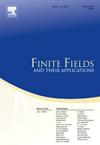Deep holes of twisted Reed-Solomon codes
IF 1.2
3区 数学
Q1 MATHEMATICS
引用次数: 0
Abstract
The deep holes of a linear code are the vectors that achieve the maximum error distance (covering radius) to the code. Determining the covering radius and deep holes of linear codes is a fundamental problem in coding theory. In this paper, we investigate the problem of deep holes of twisted Reed-Solomon codes. The covering radius and a standard class of deep holes of twisted Reed-Solomon codes are obtained for a general evaluation set . Furthermore, we consider the problem of determining all deep holes of the full-length twisted Reed-Solomon codes . For even q, by utilizing the polynomial method and Gauss sums over finite fields, we prove that the standard deep holes are all the deep holes of with . For odd q, we adopt a different method and employ the results on some equations over finite fields to show that there are also no other deep holes of with . In addition, for the boundary cases of and , we completely determine their deep holes using results on certain character sums.
扭曲的里德-所罗门密码的深洞
线性码的深孔是达到码的最大误差距离(覆盖半径)的向量。确定线性码的覆盖半径和深孔是编码理论中的一个基本问题。本文研究了扭曲Reed-Solomon码的深孔问题。对一般评价集a, Fq,得到了扭曲Reed-Solomon码TRSk(a,θ)的覆盖半径和深孔标准类。进一步研究了长度扭曲Reed-Solomon码TRSk(Fq,θ)的所有深孔的确定问题。对于偶q,利用多项式方法和有限域上的高斯和证明了标准深孔都是3q−44≤k≤q−4的TRSk(Fq,θ)的深孔。对于奇数q,我们采用了不同的方法,并利用有限域上的一些方程的结果证明了TRSk(Fq,θ)也不存在3q+3q−74≤k≤q−4的其他深孔。此外,对于k=q−3、q−2和q−1的边界情况,我们利用某些特征和的结果完全确定了它们的深孔。
本文章由计算机程序翻译,如有差异,请以英文原文为准。
求助全文
约1分钟内获得全文
求助全文
来源期刊
CiteScore
2.00
自引率
20.00%
发文量
133
审稿时长
6-12 weeks
期刊介绍:
Finite Fields and Their Applications is a peer-reviewed technical journal publishing papers in finite field theory as well as in applications of finite fields. As a result of applications in a wide variety of areas, finite fields are increasingly important in several areas of mathematics, including linear and abstract algebra, number theory and algebraic geometry, as well as in computer science, statistics, information theory, and engineering.
For cohesion, and because so many applications rely on various theoretical properties of finite fields, it is essential that there be a core of high-quality papers on theoretical aspects. In addition, since much of the vitality of the area comes from computational problems, the journal publishes papers on computational aspects of finite fields as well as on algorithms and complexity of finite field-related methods.
The journal also publishes papers in various applications including, but not limited to, algebraic coding theory, cryptology, combinatorial design theory, pseudorandom number generation, and linear recurring sequences. There are other areas of application to be included, but the important point is that finite fields play a nontrivial role in the theory, application, or algorithm.

 求助内容:
求助内容: 应助结果提醒方式:
应助结果提醒方式:


